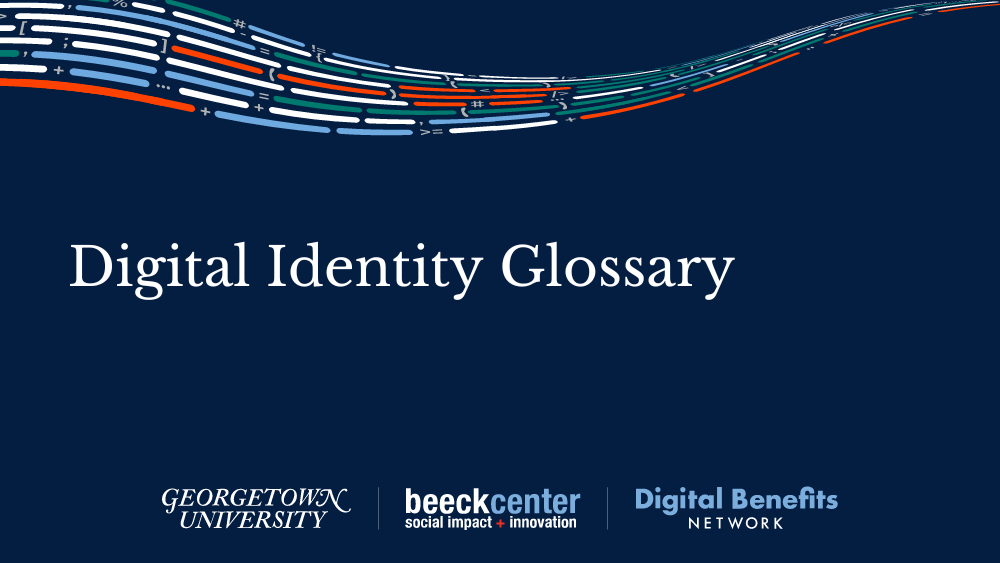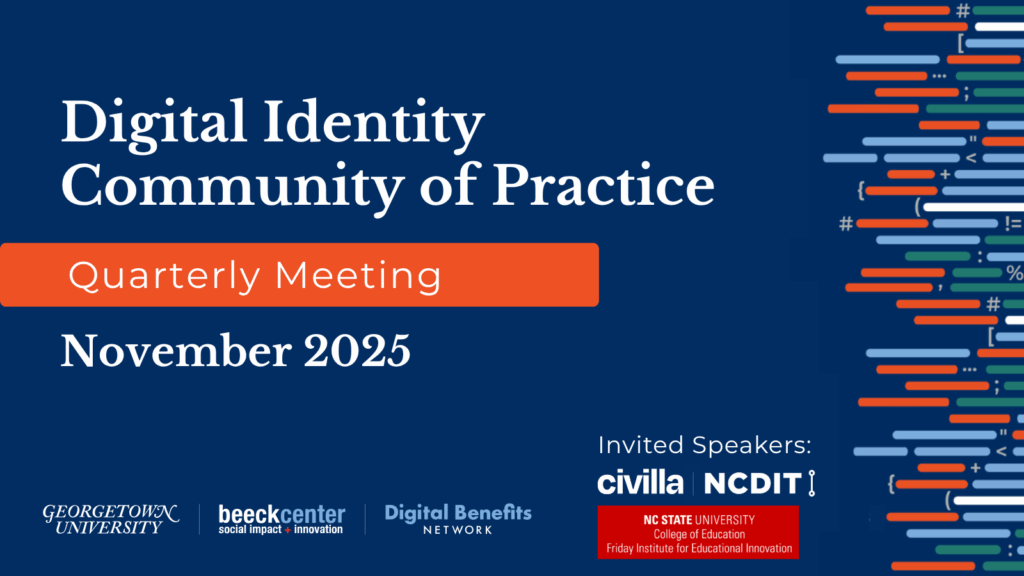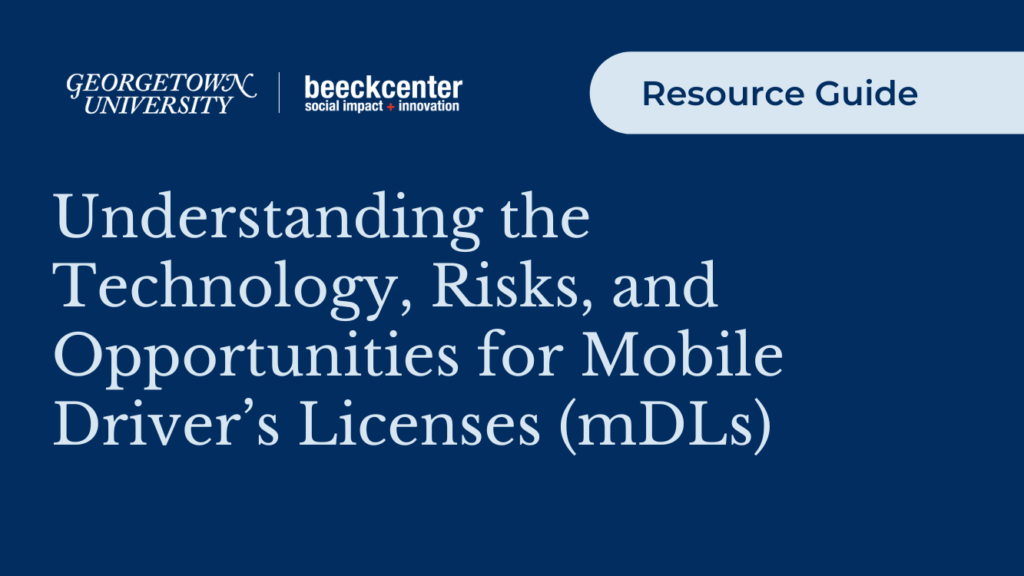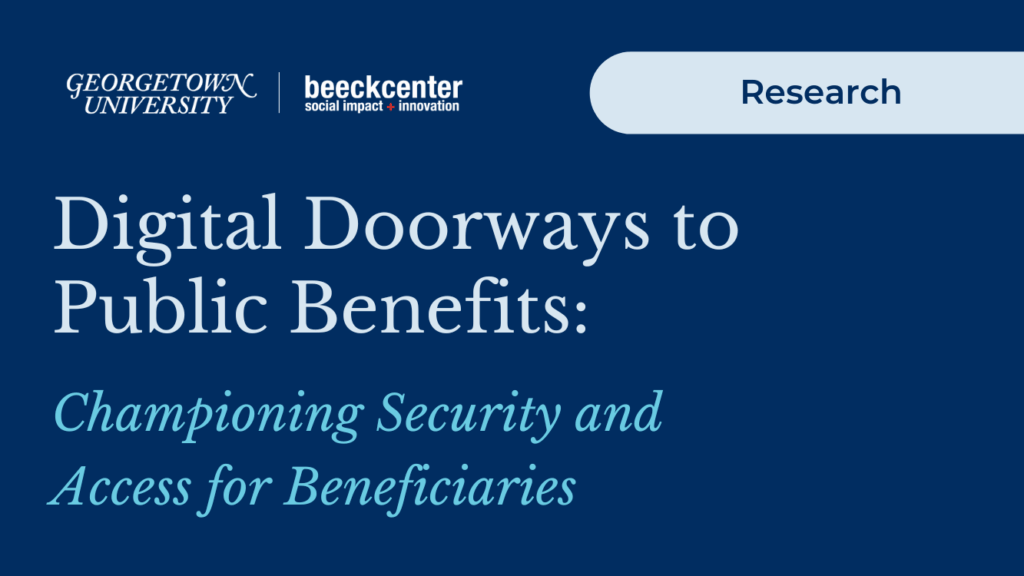2024 Edition: Account Creation and Identity Proofing in Online Public Benefits Applications
In December 2024, the Digital Benefits Network published an updated open dataset documenting account creation and identity proofing requirements across online SNAP, WIC, TANF, Medicaid, child care (CCAP) applications, and unemployment insurance applications, to help the broader ecosystem identify promising practices and areas for improvement in public benefits identity management.

Overview
The way state agencies structure online account creation processes and requirements for applicants and beneficiaries to prove who they are may impact whether and how quickly individuals can apply for and start receiving benefits. First published in 2023, this research project examines online applications across the United States for six programs: Supplemental Nutrition Assistance Program (SNAP), Temporary Assistance for Needy Families (TANF), MAGI (Modified Adjusted Gross Income) Medicaid, Special Supplemental Nutrition Program for Women, Infants, and Children (WIC), Child Care Assistance (CCAP), and Unemployment Insurance (UI) to understand when and how states use account creation, authentication, and identity proofing in initial online public benefits applications.
When we talk about digital identity, we’re often talking about how people represent information about who they are online. In the context of government services and public benefits, this involves the steps that someone trying to access a service might encounter to prove their identity, or confirm they’re the same person accessing a service each time by creating and logging into an account.
The DBN has been researching digital identity for the past two years, and our interest in this topic is based on our belief that all applicants deserve application processes that help them receive essential, life-saving benefits in a timely, dignified way. We understand that account creation and identity proofing requirements can create significant barriers for eligible applicants and for beneficiaries depending on how they’re implemented. We also recognize the value of thoughtfully-implemented identity management, alongside other cybersecurity approaches, in ensuring that public resources are stewarded properly. We know that state agencies are facing challenges balancing equitable access, privacy, and data and system security. However, commonly used approaches to understand who someone is and assess risk—like knowledge-based verification, biometrics, and fraud detection algorithms—present serious tradeoffs for security and equity. Successful identity management for public benefits requires risk-based, human-centered evaluation of when identity proofing and authentication are necessary, thoughtful selection of methods, and integration of identity management into overall service design.
In our review of online benefits applications we ask a variety of questions focused on understanding when and how states use account creation, authentication, and identity proofing in initial online public benefits applications and other aspects of the digital identity experience. By documenting the landscape of current practices, this project aims to help the broad ecosystem of peer states, federal agencies, advocates, academics, and civic tech organizations identify states that are taking unique, unusual, or potentially promising approaches. The dataset also identifies states that are putting up potential barriers through their implementation of account creation, authentication, and identity proofing.
Understanding the current landscape is only the first step in improving how digital identity is used to promote access and security in public benefits applications. We must also have a better understanding of what works for beneficiaries and applicants, identify shared challenges, and work to implement human-centered approaches in benefits delivery. In 2024, the DBN announced a new community of practice focused on digital identity in public benefits. The mission of this cross-sector community is to promote the delivery of public benefits to all eligible individuals, including vulnerable populations, by informing how digital identity approaches should be used in public benefits delivery.
The DBN is also partnering with the National Institute of Standards and Technology (NIST) and the Center for Democracy and Technology (CDT) to tailor NIST’s Digital Identity Guidelines to the unique access considerations of public benefits programs, specifically integrated applications that include SNAP and Medicaid. Read more on our project page and get involved.
Quick Takeaways
- Several states made more programs available online, either by creating new standalone applications or by adding more programs to their integrated online benefits applications.
- There was no major change in the number of applications requiring applicants to create an account to apply online in 2024 as compared to 2023.
- We found slightly more applications requiring identity proofing in 2024, up from 37 applications in 2023 to 42 in 2024.
- Identity proofing requirements or prompts remain most common in unemployment insurance applications, but we saw more state workforce agencies incorporating additional methods for identity proofing (e.g., adding in-person options for identity verification through the USPS, or adding options for in-person identity verification at a kiosk).
Read on for our analysis and explore the open dataset to dig deeper.
On this page you will find….
- Resources to Learn More about Digital Identity
- Key Findings + Cross-Program Analysis
- Open Data
- Details on our Research Questions + Process
- Information on What’s Next
Program-Specific Data + Analysis
Although many of the applications in this dataset are linked and the dataset documents applicants’ experiences when applying for all available core programs, we also wanted to provide program-specific views of this data to help users quickly review trends within individual programs. On the following pages, you can view data + analysis broken up by program, plus interactive maps documenting account creation and identity proofing requirements across states. We also know it’s important to understand program-trends alongside program-specific requirements, and those pages provide that context.
(e.g., all applications that include SNAP)
(e.g., all applications that include TANF)
(e.g., all applications that include MAGI Medicaid)
(e.g., all applications that include WIC)
Child Care Assistance Program (CCAP) Data and Analysis →
(e.g., all applications that include Child Care)
Unemployment Insurance Data and Analysis →
(all UI applications, always stand alone)
Learn More
There are many great resources to help you understand what digital identity is and why it matters for public benefits delivery. We’re highlighting several below.
Have questions these resources don’t answer? Email us at digID@georgetown.edu and we’ll try to help you find what you’re looking for.
Check out our Digital Identity Topic Page to browse all our digital identity-related resources on the Digital Government Hub. We will also highlight more information about specific program requirements and guidance on digital identity when we release follow-on publications in early 2025 that examine digital identity practices in each of the six programs included in this dataset.
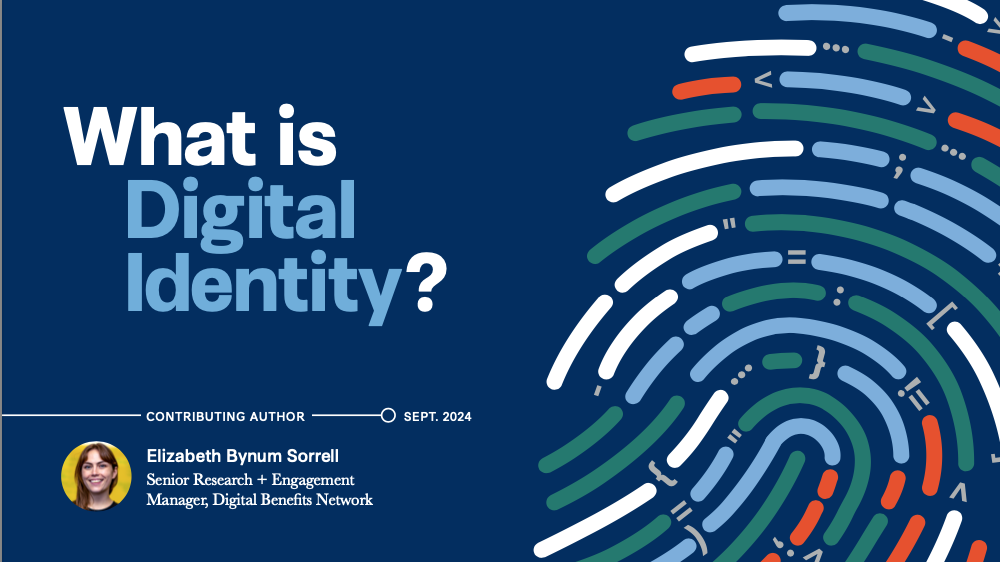
What is Digital Identity?
In this updated primer, the DBN introduces the concept of digital identity, and provides brief snapshots of digital identity-related developments internationally and in the U.S.
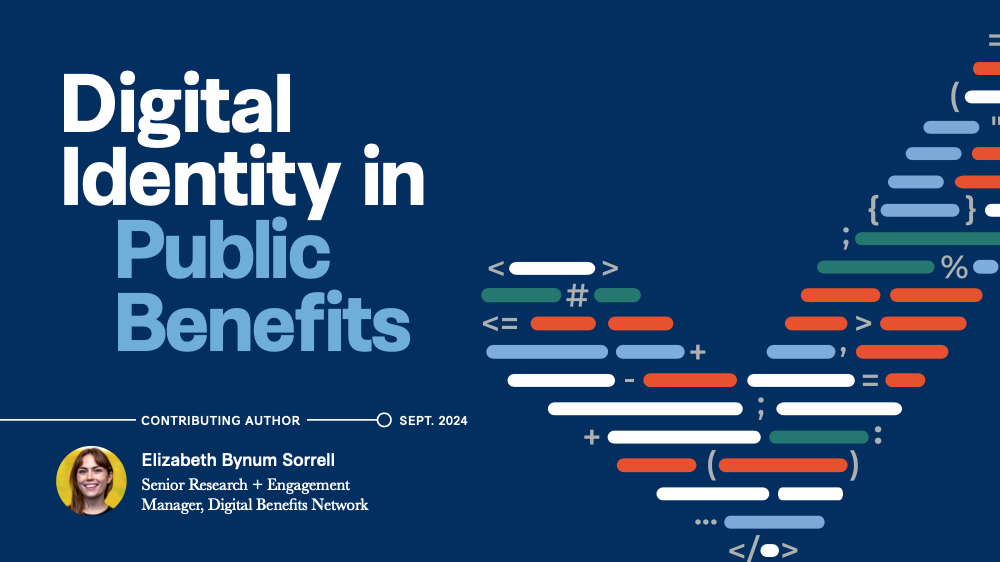
Digital Identity in Public Benefits
In this updated primer, the DBN describes how identity proofing and authentication show up in public benefits applications and outlines equity and security concerns raised by common identity proofing and authentication methods.

Remote Identity Proofing: Better Solutions Needed to Ensure Equitable Access
The report examines how current remote identity proofing methods can create barriers to Medicaid enrollment and suggests improvements to ensure equitable access for all applicants.
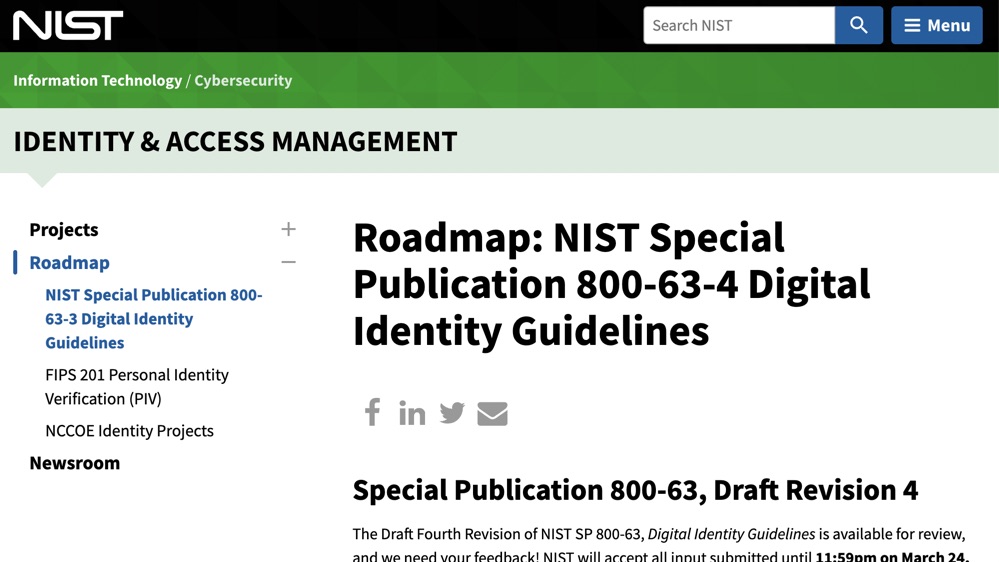
Roadmap: NIST Special Publication 800-63-4 Digital Identity Guidelines
Revision 4 of the National Institute of Standards and Technology (NIST) Special Publication 800-63, Digital Identity Guidelines, responds to the changing digital landscape that has emerged since the last major revision of this suite was published in 2017.
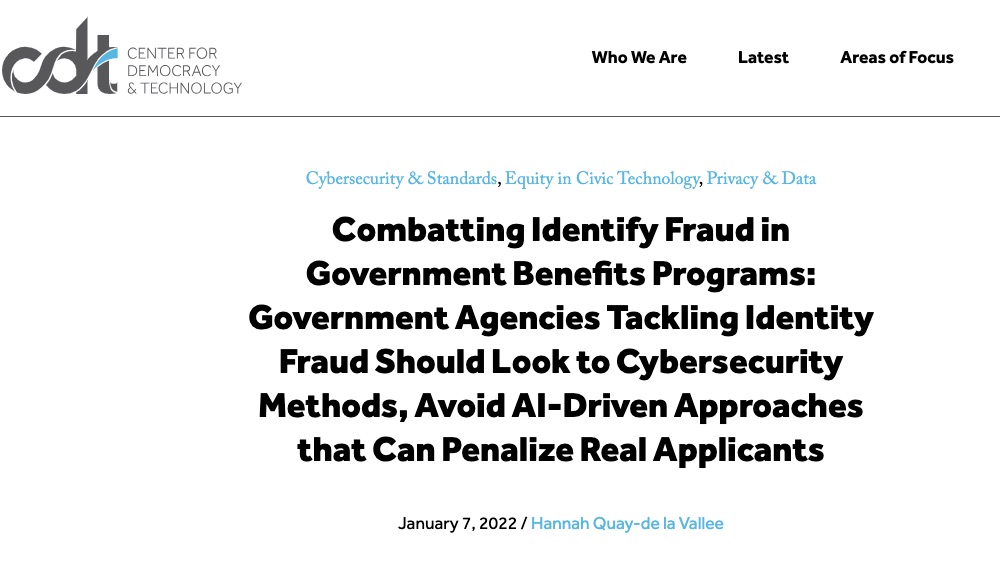
Combatting Identity Fraud in Government Benefits Programs
This post argues that for the types of large-scale, organized fraud attacks that many state benefits systems saw during the pandemic, solutions grounded in cybersecurity methods may be far more effective than creating or adopting automated systems.
Key Findings + Cross-Program Analysis
For this project, we collected data about authentication and identity proofing practices used for online applications in six federally-funded, state-administered programs: SNAP, TANF, Medicaid, WIC, child care, and unemployment insurance applications across states and territories. The final dataset includes 162 applications.
Outside of UI applications, many of the applications we reviewed for SNAP, WIC, TANF, Medicaid, and child care are combined applications that allow users to apply for more than one benefit program at a time. In order to collect this data, we reviewed application flows for all applications that include SNAP, TANF, MAGI Medicaid, WIC, and Child care, and we reviewed publicly available information about unemployment insurance applications. Read more about our research process below.
New applications + programs online
- Several states made more programs available online, either by creating new standalone applications or by adding more programs to their integrated online benefits applications.
- Highlights include Alaska’s newly online SNAP application and four newly online WIC applications or pre-applications. Six states also added online child care applications, either as standalone applications or as additions to their integrated benefits portals.
Account Creation + Authentication
- We saw similar numbers of applications requiring applicants to create an account to apply online in 2024 as compared to 2023.
- In 2024, 123 applications (or 75% of applications we reviewed) required users to create an account in order to apply for benefits online. Account creation requirements remain most common in unemployment insurance applications.
- There were more online applications using optional account creation in 2024 than in 2023, up from 14 to 19 applications.
- Another 17 applications do not appear to use account registration at any point in the application process. Seven applications do not require or prompt account creation during the application process, and allow users to come back to the site and take action (e.g., report changes, upload documentation) for their cases without an account.
- Email address is a required field in 76% of online applications that require users to have an account to submit an online application (94 of 123), and a required field in 76% of applications that either require account creation or make it optional (108 of 142).
- Thirty-six applications are using government single sign-on options (SSOs) that enable applicants to use the same login for other government services in the state. Single sign-ons can enable people to use a single set of credentials across multiple government services. However, as the DBN and the Center on Budget and Policy Priorities (CBPP) have previously written, if a single sign-on has strict security requirements, like mandatory identity proofing, that requirement can get applied across multiple services that might have different risk levels and security needs.
- Fourteen applications require or allow users to log in to an application portal with credentials from another service such as Facebook, Google, or ID.me.
- Online services may layer multiple authenticator types into account access in an effort to provide additional security. We found evidence that 128 online benefits portals (79%) prompt people to use at least one other authenticator in addition to passwords, such as one-time passcodes sent to an email address or phone number, security questions, or authenticator apps.
- Fifty-six percent of applications offer or use multiple authenticator types, which may help users choose which option works best for them.
- Twelve applications included authenticator apps as an option.
- Only one state (Michigan) is currently using passkeys as an authentication option.
- As NIST explains, “successful authentication provides reasonable risk-based assurance that the subject accessing the service today is the same as the one who previously accessed the service.” However, it’s important to note that not all authenticator options are equivalent.
- For example, we found 27 applications that appear to use security questions as the only authenticator. Security questions may create friction for applicants without offering significant security benefits. As the DBN has noted previously, NIST does not recognize security questions as an acceptable authenticator because answers to security questions are prone to data breaches.
- Additionally, authentication measures might not work equally well for all people; for example, if receiving a one-time passcode via phone is a required process, this might not be feasible for individuals who lack regular access to a mobile phone.
- The type of authentication measures used should depend on the user population in question, as well as the level of risk inherent in a given transaction. Read more about phishing-resistant authenticators and different assurance levels for authentication in NIST’s guidelines.
Identity Proofing
- We found slightly more applications requiring identity proofing in 2024, up from 37 applications in 2023 to 42 in 2024.
- Of applications that require identity proofing, 21 place identity proofing steps before a user can initiate an application, and 11 place proofing during an application process.
- When identity proofing happens matters from a service design perspective, as well as for performance metrics. In instances when identity proofing is placed in front of an application process, if an eligible individual is unable to get through an identity proofing process because of a technical issue or because they lack documentation, a state agency may not have access to information about the individual, and they may not show up in abandonment/dropoff rates.
- A total of 19 applications make identity proofing optional, and five states added optional identity proofing to their online integrated benefits applications between 2023 and 2024. This means a user can immediately skip the prompt, or, if their identity cannot be verified online, an applicant can still continue the online application process.
- Optional identity proofing is most often placed before a user starts an application (13 of 19 applications).
- Identity proofing requirements or prompts remain most common in unemployment insurance applications. We saw more state workforce agencies incorporating additional methods for identity proofing (e.g., adding in-person options for identity verification through the USPS, or adding options for in-person identity verification at a kiosk).
- In 2024, we also found 12 unemployment insurance applications that appear to only use identity proofing after someone has submitted a claim (12 in 2024 as compared to four in 2023). From an access perspective, this might enable an eligible claimant who would struggle with identity proofing to get their claim into the state system and then work to successfully complete identity proofing.
- We also found five UI applications where it appeared that identity proofing might be used for some, but not all claimants.
- Identity proofing requirements vary across programs.
- Identity proofing requirements were most common in unemployment insurance online applications. In 2024, we found that at least 58% of UI applications require some type of active identity proofing steps to apply.
- Among other benefits programs, identity proofing requirements or prompts were most common for applications that allow users to apply for MAGI Medicaid. We found 52% of applications that include MAGI Medicaid require or prompt identity proofing steps for all applicants, up from 46% in 2023.
- As we found in 2023, identity proofing prompts remain least common for WIC applications. Only one application that includes WIC—Michigan’s combined MI Bridges application for SNAP, TANF, Medicaid, WIC, and child care—prompts optional identity proofing.
- Identity proofing methods also vary between UI applications and other benefits applications.
- In 2023, we found evidence that 22 labor agencies were using biometrics for identity proofing (coded in our dataset as “ID Document Upload” plus “Video/live selfie” to emphasize the claimant experience of that process). In 2024, we found evidence that 24 state workforce agencies and one department of health and human services were using biometrics.
- When identity proofing is required or prompted in benefits programs other than unemployment insurance, agencies are primarily using knowledge-based verification and may also allow users to present identity documents in person or via mail or fax.
- This year we also tracked whether application processes that use identity proofing explicitly offer people choices about how they prove their identities. For example, some state workforce agencies that use ID.me appear to allow claimants to choose whether they want to verify via a video call or through the self-service process (document upload + live-selfie), or in-person at a kiosk. Other state workforce agencies appear to make the video call option available only if a user has been unsuccessful with the self-service process. States using Login.gov and USPS let users choose which option to use for identity proofing. Across programs, we found 21 agencies that appear to offer individuals choices about how they verify their identity.
- To add further context, this year we also included more information in our field on “Active ID Proofing Methods” to document multiple pathways agencies make available for identity proofing.
Identity Proofing Vendors
- ID.me remains the most common publicly named identity proofing vendor for unemployment insurance applications (used by 24 state workforce agencies).
- Among other benefits programs, Experian remains the most commonly named identity proofing vendor (observed for 23 applications).
- When it comes to unemployment insurance, we also found more states using public options, USPS and Login.gov.
- In our review of publicly available documentation, we found that Arkansas, Hawaii, Massachusetts, and Wisconsin use the federal government’s identity proofing and authentication service Login.gov. The General Services Administration (GSA) has publicly identified more states using Login.gov than we found information about in our data collection; in the public notes column we’ve indicated which states (Utah, West Virginia, and New Hampshire) are also using Login.gov based on information confirmed with GSA.
Digital Identity Choices
As we’ve previously written, we think choice is a key feature when it comes to digital identity in public benefits. Recognizing that beneficiaries and applicants have different levels of comfort with and access to technology, benefits administering agencies can offer beneficiaries and applicants choices about when and how to create accounts or verify their identities, if those identity management steps are relevant for a particular online interaction.
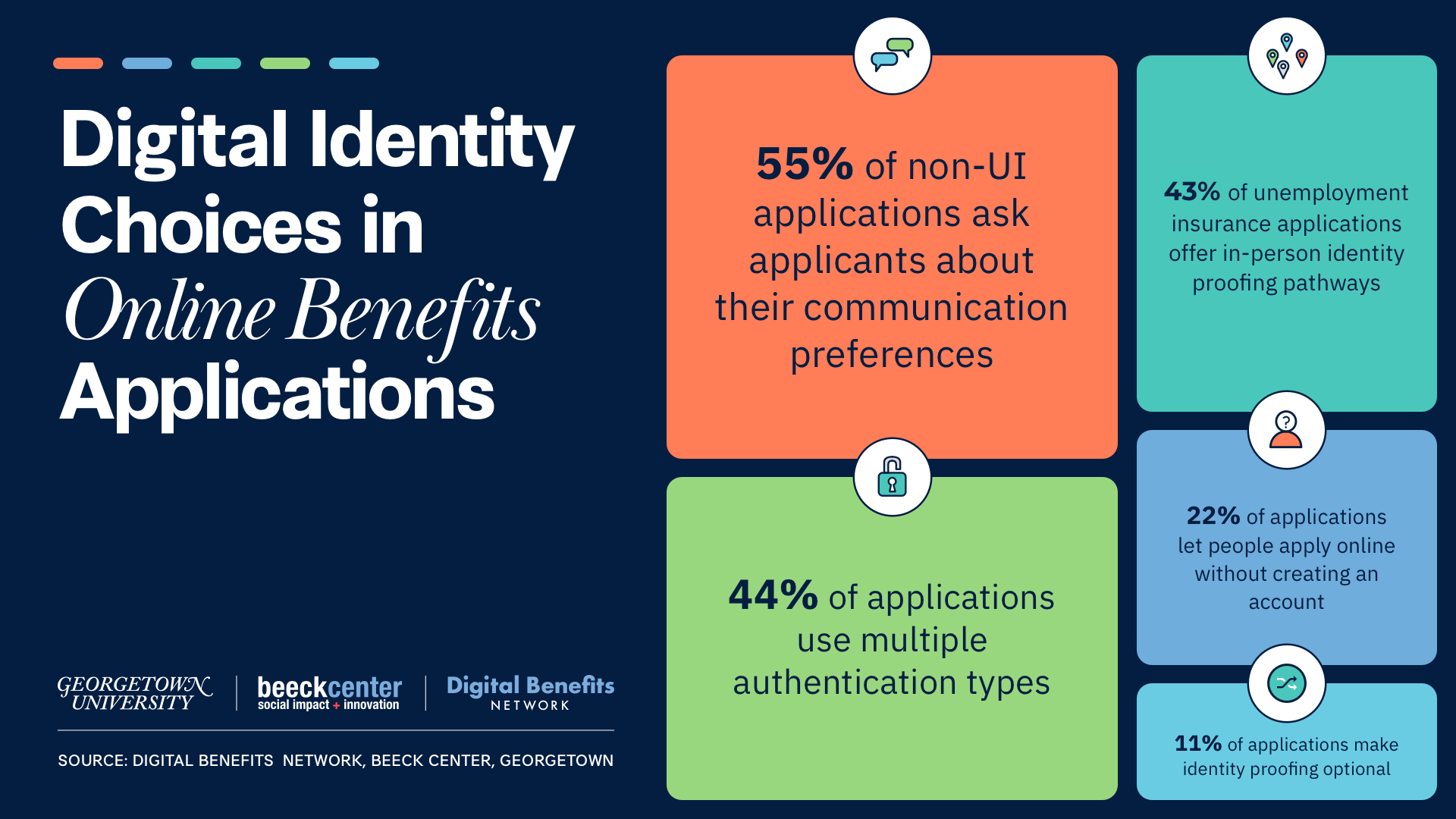
New Data Points
Information on Portals’ Password Recovery Mechanisms
- If applicants and beneficiaries are unable to use self-service pathways to regain access to their account when they forget or lose their password, this can drive up calls to call centers and prevent people from responding to important notices or requests for information.
- Of applications we reviewed that have account features, we found evidence of self-service password reset pathways in at least 72% of applications. Typically, this involved a user receiving a code via email or text, an email validation link, or answering security questions to reset their password. This is an encouraging figure in that it means applicants may be more able to regain access without additional help; however, it’s important that these processes are designed to work well for users while maintaining security.
Use of Document Uploaders
- Document uploaders can allow applicants and beneficiaries to upload important pieces of information to help verify their eligibility and other relevant pieces of information, including identity. How individuals are able to manage online access to key documents is also an opportunity area for improving access.
- More than half of the online portals we reviewed appear to include a document uploader, and at least 40% of applications make document uploaders available to applicants.
Help Pathways
- Ideally, application processes are straightforward, but the ways in which applicants can access help and information (through things like FAQ pages, video tutorials, chat features, etc.) matter for strong, equitable access.
- Most applications we reviewed (76%) offer more than one help pathway for users to choose from.
Communications Preferences
- Reaching applicants via the medium they are most comfortable with or are most likely to have access to could help ensure eligible individuals complete application requirements and maintain benefits.
- In 2024, we tracked which applications prompt applicants to share their communications preferences during an application process (e.g., email vs. text vs. phone call, or asking about time of day preferences).
Portal Actions
- All the portals in our dataset allow individuals to apply for benefits. But many portals let users take other actions, like uploading documents, reporting changes, or renewing their benefits. In this year’s update to the dataset, we added a field to formally track actions that someone can take on a portal, including:
- Apply for Benefits
- Check Application Status
- File Weekly Certification (only relevant for UI)
- Renew Benefits
- Report a Change
- Uploading Documentation
- View Notices
- View Payment Amount/Benefit Coverage
- View/Manage Appointments
- Voter Registration
- A majority of applications allow users to upload documentation (55%), and many applications enable users to report changes (at least 55% of non-UI applications) and renew their benefits online (at least 52% of non-UI applications).
Open Data
This Airtable view displays data about authentication and identity proofing practices in online SNAP, TANF, Medicaid, WIC, child care, and unemployment insurance applications across states and territories. You can use filters to view data for specific programs and jurisdictions, or to highlight different variables.
This Airtable view displays data about authentication and identity proofing practices in online SNAP, TANF, Medicaid, WIC, child care, and unemployment insurance applications across states and territories. You can use filters to view data for specific programs and jurisdictions, or to highlight different variables.
Research Questions + Process
For this project, we collected data about authentication and identity proofing practices used in online applications of six federally-funded, state-administered programs: SNAP, TANF, MAGI Medicaid, WIC, child care, and unemployment insurance applications across states and territories.
We wanted to answer several core questions, including:
- When and how is identity proofing identity proofing used across online applications for public benefits programs?
- When and how are account creation and authentication processes used across programs?
- What types of personally identifiable information (PII) do applicants need to supply in order to apply online?
In updating our dataset in 2024, we also sought to compare our findings against the information we collected in 2023.
To answer our research questions, we independently collected details about unemployment insurance applications using publicly-available information about UI applications from agency websites, application portals, claimant guides, news coverage, vendor websites, and contracting repositories. For SNAP, TANF, WIC, MAGI Medicaid, and child care applications we collected data by reviewing online application flows without submitting applications.
The final dataset includes 162 applications. Outside of UI applications, many of the applications we reviewed for SNAP, WIC, TANF, Medicaid, and child care are combined applications that allow users to apply for more than one benefit program at a time. Read more about our research process on this page.
Questions?
As always, we’re eager for your feedback! Did we miss something when reviewing a state’s application? Do you have research questions you’d like us to try and answer using the information in this dataset? If so, email us at digID@georgetown.edu.
Get Involved
Digital Identity Community of Practice
In 2024, the DBN announced a new community of practice focused on digital
identity in public benefits. The mission of this cross-sector community is to promote the delivery of public benefits to all eligible individuals, including vulnerable populations by informing how digital identity approaches should be used in public benefits delivery. Learn more and join our CoP by visiting the Community of Practice home page.
Collaborative Research with NIST and CDT
The DBN is also partnering with the National Institute of Standards and Technology and the Center for Democracy and Technology to tailor NIST’s Digital Identity Guidelines to the unique access considerations of public benefits programs, specifically integrated applications that include SNAP and Medicaid. Read more on our project page and get involved.
Acknowledgments
- We would like to thank the Georgetown students who supported this project while working as student analysts with the DBN, including Anvitha Reddy and Isabelle Granger, who completed the bulk of data collection and data entry for this project, and Miranda Xiong and Olivia Zhao who were instrumental in quality-checking and analyzing our findings and creating data visualizations.
- In 2023, Code for America and the Beeck Center established a data sharing partnership that facilitated the development of these datasets, and invited the Beeck Center to help update their Benefits Enrollment Field Guide. We’d like to thank our partners at Code for America for their continued thought partnership and consultation as we updated our dataset in 2024.
- We would also like to thank Justin Duncan who provided graphic design support, and Ashleigh Fryer who provided copy-editing support.
Citation
Cite as: Elizabeth Bynum Sorrell, Ariel Kennan, Anvitha Reddy, Isabelle Granger, Miranda Xiong, Olivia Zhao, and Quinny Sanchez Lopez, “2024 Edition: Digital Account Creation and Identity Proofing in Public Benefits Applications” Digital Benefits Network, December 4, 2024.
Data Licensing
We’ve invested in making great data that’s open to use under Creative Commons Attribution 4.0 International (CC BY 4.0).
Want to make your own project? Go for it!
You are free to:
- Share: Copy and redistribute the material in any medium or format
- Adapt: Remix, transform, and build upon the material for any purpose, even commercially.
We ask that you provide attribution—you must give appropriate credit, provide a link to the license, and indicate if changes were made.
